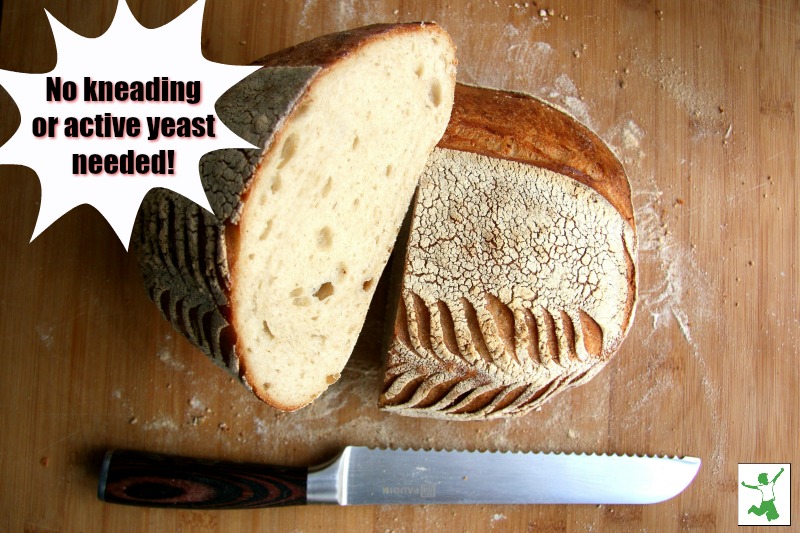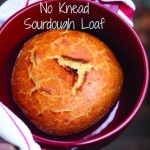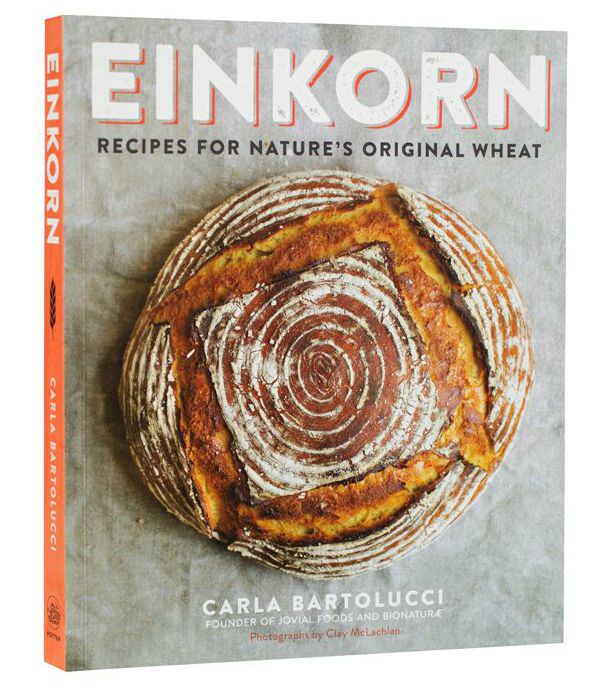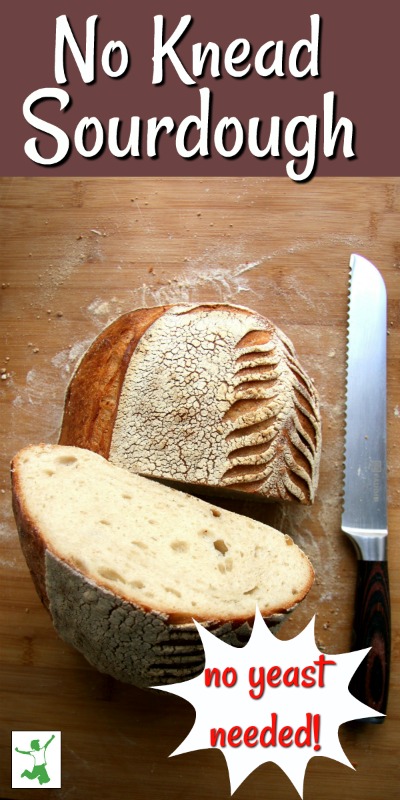
Easy, no knead recipe for einkorn sourdough bread with only 3 ingredients and no active yeast required for extra digestibility and more easily assimilated nutrition.
I am so excited to add this amazing recipe for no knead einkorn sourdough bread to the catalog of nearly 400+ Real Food recipes (including 16 bread recipes) on this blog!
This authentic, yeast free sourdough creation comes from Carla Bartolucci, one of the world’s foremost experts in the cultivation and traditional preparation of einkorn, the only nonhybridized form of wheat on Planet Earth. For many (non-genetically) gluten intolerant people, this is the only wheat they can eat and enjoy without symptoms.
Carla’s book Einkorn: Recipes for Nature’s Original Wheat is a treasure trove for anyone who values ancient culinary traditions using ingredients such as einkorn that have safely nourished and delighted humanity for millennia.
For those of you who are new to bread baking and sourdough in particular, this is a recipe you should try first because it requires no kneading or shaping of the dough. Despite the little effort required, the resulting loaf looks like an artisan produced it!
The only catch is that you really need a 5-7 quart Dutch oven for baking. Simply mix together the ingredients in the evening before you go to bed. In the morning, fold the dough into a rough round, and your fresh einkorn sourdough loaf will be out of the oven in less than an hour!
Homemade Sourdough
Thank you, Carla, for your generosity in allowing the reprinting of this fantastic homemade sourdough bread recipe, but most importantly, for writing this book … it is truly a gift to the world.

No Knead Sourdough Bread Recipe
Easy recipe for no knead sourdough bread using einkorn flour that even many gluten intolerant people can enjoy.
Ingredients
- 2 cups (474 g) warm filtered water 100°F/37.8°C
- 1/4 cup (60 g) refreshed sourdough starter see einkorn-based recipe below
- 6 cups (720 g) all-purpose einkorn flour
- 1 1/2 tsp sea salt finely ground
Instructions
-
In a large bowl, mix together the water and yeast or starter until dissolved and creamy. Add the flour and salt and mix until all of the flour is absorbed and you have a sticky dough. Cover the bowl with plastic wrap and let rise in a dark place for 10 to 15 hours until the dough has doubled in size.
*Note that if you choose the yeast starter, your loaf will not convey the health benefits of sourdough. More on spotting fake sourdough at the store in this article.
-
Generously flour a work surface and transfer the dough to it. Use a dough scraper to fold the dough in thirds, dusting with flour as you go, then cup the dough with both hands and rotate in a circular motion between your hands until you have a tight, round loaf. Dust the top of the dough generously with flour.
-
Place a linen layer in a colander, heavily dusted with flour. Place the loaf seam side up in the colander, then fold over the linen to cover. Let proof at room temperature for 30 minutes.
-
Place a Dutch oven with the lid on in the oven. Preheat the oven to 500°F/260°C for 30 minutes.
-
Remove the pot from the oven and take off the lid. Invert the loaf and place it in the pot seam side down. Shake to center it, but if it sticks to the side leave it. Cover and place in the oven.
-
Reduce the oven temperature to 450°F/232°C and bake for 40 minutes. At this point, you can remove the pot from the oven and take off the lid. If you like your loaf darker, return the uncovered pot to the oven for 5 minutes.
-
Lift the loaf out of the pot with oven mitts. Place on a wire rack to cool for 2 hours before slicing. Wrap the loaf in a clean cotton or linen kitchen towel for up to 3 days, or freeze in a sealed plastic bag for up to 1 month.
Recipe Notes
1⁄4 teaspoon active dry yeast may be substituted for the einkorn sourdough starter in a pinch. Using sourdough starter will result in a more digestible loaf, however.
7 1⁄4 cups (696 g) whole grain einkorn flour, plus more for dusting can be substituted for the 6 cups of all purpose einkorn flour.
Hint! Once you’ve made your loaf, save the crusts and check out this recipe on how to make breadcrumbs.
How to MAKE an Einkorn Sourdough Starter
It will normally take 6 to 10 days to get your starter strong enough to bake great bread. At that point, the starter may be stored in the refrigerator and refreshed just once a week. You can create and maintain the starter with either all-purpose or whole grain einkorn flour. The whole grain flour contains 100 percent of the seed and a bit more of the wild yeasts, which can help things to move along quicker in the beginning, but both flours will end up working equally as well.
MAKES 1 CUP OF STARTER
TO BEGIN THE STARTER
3 tablespoons (45 g) warm water, at 100°F/37.8°C
1⁄2 cup (60 g) all-purpose einkorn flour or 1⁄2 cup (48 g) whole grain einkorn flour, plus more for dusting
TO FEED THE STARTER
2 tablespoons (30 g) warm water, at 100°F/37.8°C
1⁄2 cup (60 g) all-purpose einkorn flour or 1⁄2 cup (48 g) whole grain einkorn flour, plus more for dusting
TO FEED AND FINISH THE STARTER
2 tablespoons (30 g) warm water
1⁄2 cup (60 g) all-purpose einkorn flour or 1⁄2 cup (48 g) whole grain einkorn flour, plus more for dusting
(a) In a small bowl, mix together the water and flour with a fork to form a wet dough. (b) Dust your hands lightly with flour, scrape up the dough, and roll gently between your hands into a sticky ball without adding more flour. (c) Transfer to a sealable glass jar or container, or simply leave it in the bowl and tightly seal with plastic wrap. Store the bowl in a dark place for 48 hours where it is at least 68°F/20°C.
After 48 hours of resting, the starter should smell sharp and have expanded minimally, with bubbles visible under the pale gray surface of the dough. (d) With a fork, gently push aside and discard the gray surface of the dough. (e) Gather up the remaining starter and transfer it to another medium bowl. Add the water and mix until the mixture is smooth and creamy. Add the flour and mix until a wet dough is formed.
Dust your hands lightly with flour, scrape up the dough, and roll gently between your hands into a sticky ball without adding more flour. Transfer to a clean and dry sealable glass jar or container or to a clean bowl and tightly seal with plastic wrap. Store in a dark place for 24 hours where it is at least 68°F. (Some say you should cover the container with a cotton towel so the starter is able to catch wild yeasts in your kitchen. However, all of the wild yeast you need is already in the flour, and the added air can form a skin on the surface of the starter.)
After the fed starter has rested 24 hours, it should begin to change from a sharp to a sweeter, yogurtlike smell. You should begin to see bubbles not only under the surface of the dough, but also on top. (f) If you still see a grayish hue on the surface of the starter, push it aside with a fork and discard it. Add the water and mix until the mixture is smooth and creamy. Add the flour and mix until a wet dough is formed. Dust your hands lightly with flour, scrape up the dough, and roll gently with your hands into a sticky ball without adding more flour. Transfer to a clean and dry sealable glass jar or container or simply transfer to a new bowl and tightly seal with plastic wrap. Store in a dark place for 24 hours where it is at least 68°F/20°C.
After this final 24 hours, you may bake with the starter, but it will not be as mature as the starter used in my recipes. (g) Therefore, the proofing times will need to be increased from 3 to 5 hours to 12 to 15 hours, or your bread may bake dense until you have the proper balance of acids. I recommend strengthening your starter even further before you mix your first loaf of bread. To do this, you should refresh your starter (see page 13 of Einkorn cookbook) at least 5 times until it bubbles up and subsides in less than 5 hours after each refreshing. You can still bake great bread while your starter is maturing, by using Yeast Levain (page 14 of Einkorn cookbook) and mixing in the excess starter you have each time you refresh.
The same recipe for refreshing is used to strengthen your new starter and to maintain your mature starter forever. Once your starter is strong enough to leaven the dough in the times indicated in each recipe, you will only need to refresh your starter weekly to keep it strong. However, if you are away, even for a few weeks, your starter will survive just fine without refreshing if stored in a sealed container in the refrigerator. (I’ve given you quantities for refreshing your starter based on how many loaves of bread you might want to make each week.)
How to REFRESH an Einkorn Sourdough Starter
makes about 1⁄3 cup (100 g), enough for 3 loaves of bread per week
2 teaspoons (10 g) Einkorn Sourdough Starter
2 tablespoons (30 g) warm water, at 100°F/37.8°C
1⁄2 cup (60 g) all-purpose einkorn flour or 1⁄2 cup (48 g) whole grain einkorn flour
makes about 2⁄3 cup (165 g), enough for 5 or 6 loaves of bread per week
4 teaspoons (20 g) Einkorn Sourdough Starter
1⁄4 cup (56 g) warm water, at 100°F/37.8°C
3⁄4 cup plus 1 tablespoon (100 g) all-purpose einkorn flour or 3⁄4 cup plus 1 tablespoon (90 g) whole grain einkorn flour
Refreshing Directions
Place the starter in a small bowl. Add the water and mix with a fork until the mixture is smooth and creamy. Add the flour and knead to form a firm ball. Roll the starter between your hands until the flour is absorbed; add a tiny bit more if it seems overly sticky, but the dough should remain very moist. Store in a large sealed container (so you have room for the starter to expand) for 6 to12 hours. The starter will bubble up and then subside. Refrigerate the starter until you refresh it again. Remember to always leave your einkorn starter in a dark place because light can oxidize the carotenoids in the flour.
To bake bread, you will remove a small piece of the starter to mix a sourdough levain the night before baking. Some recipes will also call for kneading the dough straight with the starter. Remember to monitor the amount of sourdough that remains, because you will always need to have at least 2 teaspoons (10 g) for refreshing.
Remember: The original einkorn starter you create can survive forever and be passed on to your children, so make a note of when you begin so you’ll know how old your starter is as the years pass! If you need tips on safely storing sourdough starter for when you go on vacation or take breaks from breadmaking, this linked article tells you how.
More Information
Can Celiacs Eat True Sourdough Bread?
Make Your Own Sourdough Starter
Kefir Soaked Einkorn Loaf
Einkorn: The Good Gluten You Can Probably Eat Just Fine
Einkorn Sourdough Crackers with Nut Butter
The 4 Reasons Why I Switched to Einkorn Wheat










I’m curious how long you spend moving the dough in a circular motion? I do this for several minutes, adding flour as the dough sticks to the bread board. When I feel it’s in a ball (never tight because I fear working it too much) I put in colander to proof. After 30 minutes, I turn it over into the hot cast iron but it then spreads out and I’m not getting a tight round loaf as described. Am I not turning it long enough perhaps?
At any point during the making of the starter am I discarding any more than the grayish part? Some recipes have you discard up to half the starter. What about as I maintain the starter… am I discarding half before feeding?
No discarding necessary. The instructions per Carla’s recipe are sufficient 🙂
I’m open to anyone’s feedback! Please!
Hi Sarah,
Thank you for all of your diligent research and sharing of your knowledge. It is a breath of fresh air to have “real” answers apart from capitistic agendas
Don’t get me wrong….I appreciate capitalism…but when it comes to nutrition there are too many smoke and mirrors. Before I began my new baking journey I have a few questions, please.
1.) Is it suggested that we order Einkorn from Italy, of so from where. Or is it okay to buy whatever brand our local health food store carries?
2.Have you ever altered this recipe by combining the Einkorn with any other grains (ie millet, taff or buckwheat). Jf so, do tell????
3.Now this question is probably strange because I know as much about making bread as 5 year old. With that said, would it be advantageous for health purposes to also ferment the Einkorn first with lactobacilli before adding to bread recipe. So then I would have fermented grain broken down and would also use your awesome starter recipe. Is doing both good? Or is this overkill since einkorn has little gliadin(gluten)?
Thanks in advance for your help and as you have suggested I will purchase Carla’s book.
All the best to you.
In answer to your three questions … Yes, buy whatever einkorn fits your budget. I suggest buying only organic though as conventional wheat is commonly sprayed with herbicides just before harvesting.
I have not experimented with other grains with this recipe.
This recipe already utilizes sour leavening so you don’t have to do anything more than what the recipe says to ferment the dough. Hope that makes sense!
Hi, what are some good places to buy decently priced einkorn flour?
Einkorn flour is more expensive than regular flour. There aren’t a lot of places that sell it yet, but currently the best place to get it is jovialfoods.com
I’m curious how long you spend moving the dough in a circular motion? I do this for several minutes, adding flour as the dough sticks to the bread board. When I feel it’s in a ball (never tight because I fear working it too much) I put in colander to proof. After 30 minutes, I turn it over into the hot cast iron but it then spreads out and I’m not getting a tight round loaf as described. Am I not turning it long enough perhaps?
I couldn’t get this starter to work. In past experiences starter is much more wet. With the recipe for this starter, there is too much flour to water and I ended up with a hard lump of dough, instead of a stiff pancake batter consistency where the bacteria can move around more easily. It did eventually start to ferment, but then when I would refresh it with even less water than the original recipe it was so stiff and dry I had a difficult time even mixing it fully and when it sat the outside would dry and turn gray. I was using fresh ground whole wheat flour instead of Einkorn, though so maybe that made the difference? I found the proportions of 3/8 cup flour to 1/4 cup water to work much better and to feed it every 12 hours for 8 days, dumping half the starter out first before adding fresh flour and water in same proportions after the 2nd feed. With this new recipe I was able to get a starter that would rise a good loaf of bread in a little over a week.
I’m wondering if you are using the right kind of einkorn flour. Making a starter with whole einkorn is different than making it with white einkorn flour.
Can 6 cups freshly ground einkorn be used instead of the einkorn all purpose?
The freshly ground einkorn will have more bran in it than the all purpose einkorn. There are slight differences between baking with these two. It is very well described in Carla’s einkorn cookbook. I would suggest reading up on that to ensure the recipe turns out for you with that substitution.
Where have I gone wrong, just went to proof my loaf following your recipe and it was such a gooey, wet mess, it wouldn’t fold and I basically had just a floured slop in the proofing container. Looks like others have had this too but I didn’t see any responses to what may have gone wrong. Thanks in advance!
I really don’t know what to tell you. It works fine for me and others who have followed this recipe in Carla’s einkorn cookbook. Perhaps review the recipe carefully and see if it was followed closely enough?
Is the grams of water correct?
I used whole grain einkorn and the dough was so loose and wet and wouldn’t firm up enough to make a ball. I’ve done plenty of no knead recipes befor and this was the wettest dough in my experience. First time working with einkorn though and I used my organic rye starter.